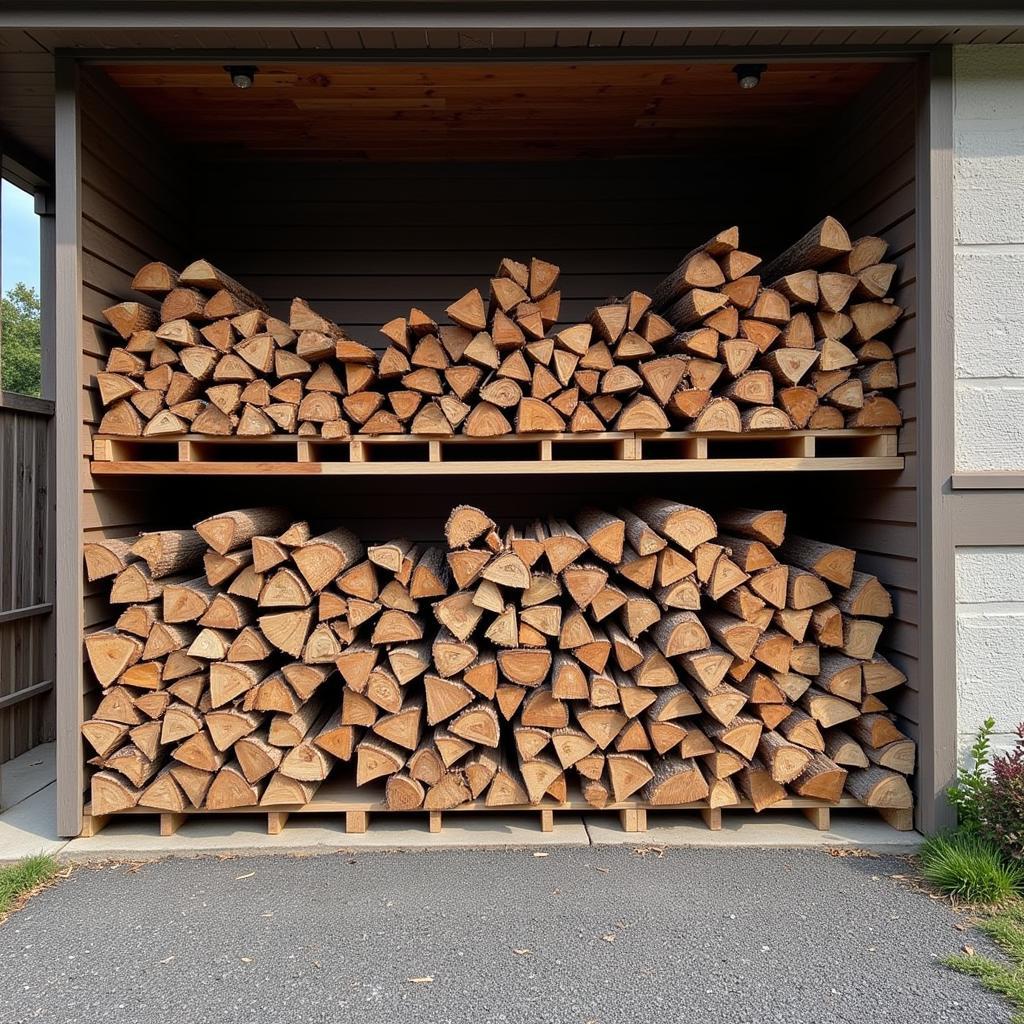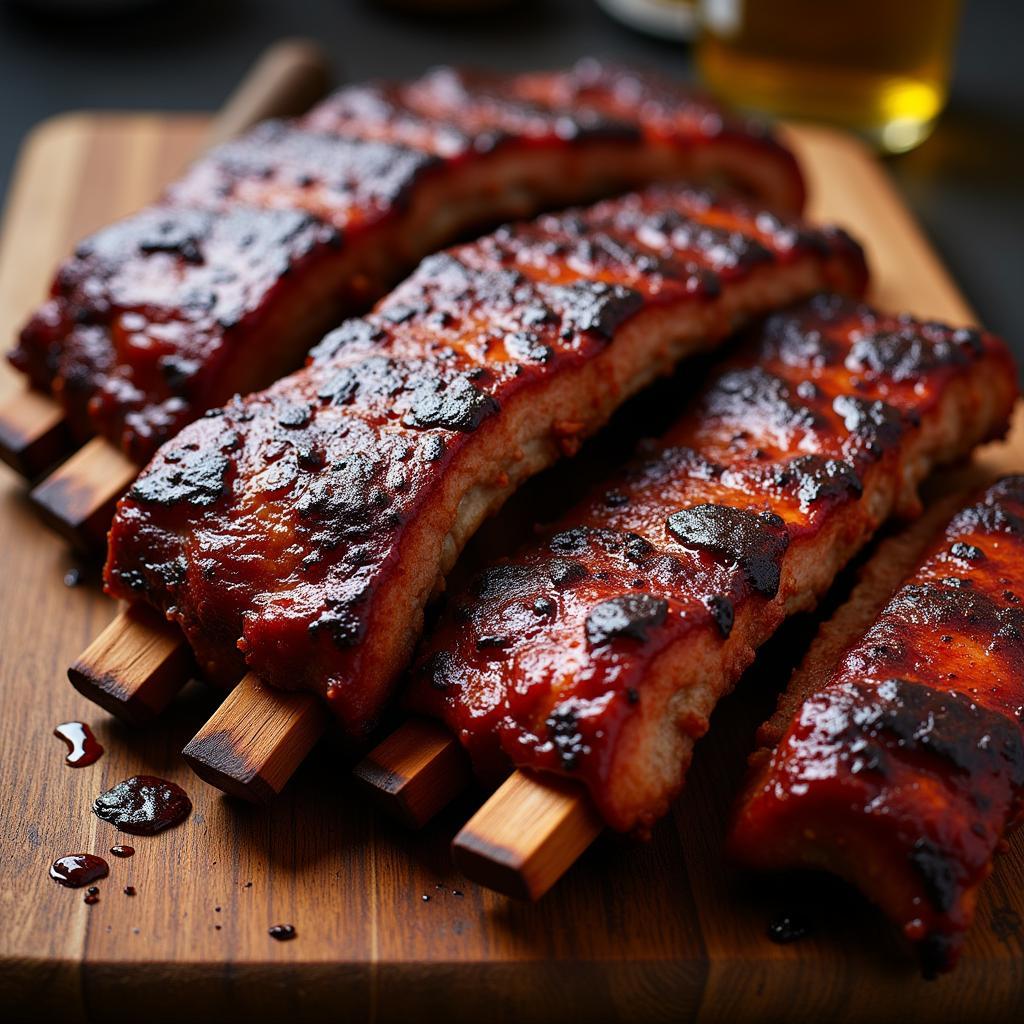Smoking food is an art, and like any art form, the medium you choose matters. Wood For Smoking Food isn’t just fuel; it’s a key ingredient that imparts unique flavors and aromas to your culinary creations. Choosing the right wood can elevate your barbecue from good to unforgettable.
Choosing the best wood for smoking food can feel overwhelming with so many options available. This guide dives deep into the world of smoking woods, exploring different types, their flavor profiles, and ideal food pairings. We’ll also cover essential tips for storing and using wood for smoking, helping you master the art of smoke and flavor. Check out our selection of food smoking accessories to enhance your smoking experience.
Understanding Wood for Smoking Food
Why Wood Choice Matters
Different woods burn at different temperatures and release varying amounts of smoke. The type of wood also influences the flavor profile of your smoked meats, vegetables, or even cheeses. Using the wrong wood can result in a bitter or overpowering taste, while the right wood can complement and enhance the natural flavors of your food.
Hardwoods vs. Softwoods: A Crucial Distinction
Never use softwoods like pine or fir for smoking. They contain high levels of resin, which creates a sooty, bitter smoke and can even be toxic. Always opt for hardwoods, which burn cleaner and slower, producing the delicious, flavorful smoke we crave.
Exploring Popular Wood for Smoking Food
Fruity Woods: Apple, Cherry, and Peach
These woods impart a mild, sweet, and slightly fruity flavor. They’re excellent choices for poultry, pork, and even some fish. Applewood is a versatile option, offering a subtle sweetness that won’t overpower delicate flavors. Cherry wood adds a slightly tart and fruity note, while peach wood provides a more intense sweetness.
Nutty Woods: Hickory and Pecan
Hickory is a classic smoking wood, known for its strong, bacon-like flavor. It’s ideal for ribs, pork shoulder, and beef. Pecan offers a milder, sweeter nuttiness, making it a great choice for poultry and vegetables. You might also enjoy experimenting with different woods in a food smoking box.
Strong Flavored Woods: Mesquite and Oak
Mesquite is the strongest flavored smoking wood, with an intense, earthy, and slightly bitter taste. It’s best used sparingly, particularly for red meats like beef brisket. Oak is a more versatile option, providing a medium-strength smoky flavor that works well with a wide range of meats.
 Different Types of Smoking Wood
Different Types of Smoking Wood
Tips for Using Wood for Smoking Food
Soaking vs. Dry: The Great Debate
Some people soak their wood chips before smoking, believing it helps them produce more smoke. However, this isn’t necessary with hardwoods. In fact, wet wood can actually hinder the smoking process by lowering the temperature of your smoker.
Wood Chunk Size Matters
Larger wood chunks burn slower and produce a more consistent smoke than smaller chips. If you’re using a smoker that requires smaller pieces, consider using wood chunks and breaking them down as needed. Visit our smokers food truck to sample a variety of smoked delicacies.
Storing Your Wood
Proper storage is crucial for maintaining the quality of your wood for smoking food. Store it in a dry, well-ventilated area to prevent mold and mildew growth.
 Proper Wood Storage for Smoking
Proper Wood Storage for Smoking
What wood is best for smoking all types of food?
Oak is a versatile and widely accessible wood that works well with almost all types of food. It imparts a balanced smoky flavor that complements, rather than overpowers, the natural tastes of the food being smoked.
How long does wood for smoking food last?
Properly stored dry wood can last for several years. Ensure it’s kept in a dry, well-ventilated area to prevent mold and mildew.
“The quality of your smoking wood directly impacts the flavor of your food,” says renowned pitmaster, John “Smoky” Smith. “Choosing the right wood is as important as choosing the right ingredients.”
Conclusion
Choosing the right wood for smoking food is a fundamental aspect of achieving delicious, smoky results. By understanding the different types of wood and their flavor profiles, you can elevate your barbecue to new heights. Experiment with various woods to discover your favorites and create truly unforgettable culinary experiences. Now that you’ve explored the art of selecting wood for smoking food, enhance your knowledge of smoked cuisine by learning about smoked vegan food. Consider the type of wood you use as carefully as you choose your ingredients, and your efforts will be rewarded with flavorful, smoky masterpieces.
FAQ
- Can I mix different types of wood for smoking?
- How much wood do I need for smoking?
- What’s the difference between wood chips, chunks, and logs?
- Can I use wood from my backyard for smoking?
- How do I know when the wood is ready in my smoker?
- Is it safe to reuse wood for smoking food?
- Where can I buy high-quality wood for smoking?
 Smoked Ribs with Hickory Wood
Smoked Ribs with Hickory Wood
Common Scenarios
-
Scenario 1: You’re smoking chicken for the first time and want a subtle smoky flavor. Consider using applewood.
-
Scenario 2: You’re preparing a brisket for a competition and need a robust smoky profile. Try a combination of oak and mesquite.
-
Scenario 3: You want to experiment with smoking vegetables. Pecan or cherrywood are excellent options.
Further Exploration
Check out our other articles on hog wild bbq food truck for more inspiration.
Need help?
Contact us at Phone Number: 02437655121, Email: minacones@gmail.com or visit our location: 3PGH+8R9, ĐT70A, thôn Trung, Bắc Từ Liêm, Hà Nội, Việt Nam. We have a 24/7 customer service team.